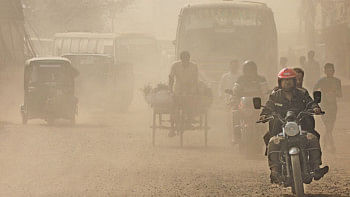Air purifiers are no substitute for policy actions

We're less than enthused by the news that Dhaka North City Corporation (DNCC) is planning to install 25 to 30 industrial-grade air purifiers in different locations—an initiative that seems more like a publicity gimmick than a meaningful step towards resolving our air pollution crisis. True, the purifiers come at no direct cost to the city, as they are being funded through a corporate social responsibility (CSR) initiative. But quick fixes, even when seemingly "free," carry the opportunity cost of not addressing what truly matters.
The science behind this should have been illustrative enough. In Dhaka, the average concentration of PM2.5—the most harmful of air pollutants—is about 18 times the global standard. Although about one-third of these pollutants come from outside the country, the rest are generated locally, thanks to illegal brick kilns, uncovered construction sites, vehicular emissions, open waste burning, household fuel use, and so on. But instead of tackling these pollutants head-on, and at the root, the authorities are again reaching for cosmetic fixes. Just as the ill-conceived solar-powered traffic lights and escalator bridges once became symbols of dysfunction, we fear these purifiers, or smog towers, too may end up as another high-maintenance, low-impact artifact gathering dust.
The science behind this should have been illustrative enough. In Dhaka, the average concentration of PM2.5—the most harmful of air pollutants—is about 18 times the global standard. Although about one-third of these pollutants come from outside the country, the rest are generated locally, thanks to illegal brick kilns, uncovered construction sites, vehicular emissions, open waste burning, household fuel use, and so on. But instead of tackling these pollutants head-on, and at the root, the authorities are again reaching for cosmetic fixes.
There is a lesson to be learnt from the case of Delhi which, according to an article by Prothom Alo, spent millions installing smog towers in 2019. Later, the Central Pollution Control Board of India estimated their impact to be negligible. China's Beijing, in contrast, achieved a 35 percent reduction in PM2.5 over five years—not by installing purifiers, but by relocating coal-based industries, adopting clean energy, regulating emissions, and investing in public transport. The message from these examples is clear. The DNCC claims that each of the purifiers is equivalent to 80-100 trees in terms of cleaning the air. But wouldn't it make far more sense to simply plant trees instead, especially considering the maintenance and security challenges associated with air purifiers?
The truth is, the DNCC project reeks of short-term thinking. The authorities are going for feel-good fixes—having failed to tackle the sources of air pollution—just like they recently greenlit a project to install traffic lights at 22 intersections across Dhaka, despite past failures of such projects. We must recognise that Dhaka's pollution crisis is too dire for short-term fixes. To reduce air pollution meaningfully, what we should do is focus on expediting efforts to close illegal kilns, enforce dust control at construction sites, phase out old vehicles, expand electric and mass transit, and strengthen our air monitoring and enforcement frameworks.


 For all latest news, follow The Daily Star's Google News channel.
For all latest news, follow The Daily Star's Google News channel. 









Comments